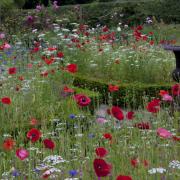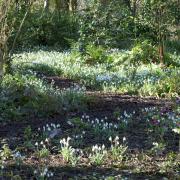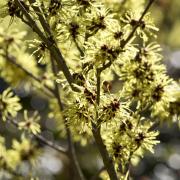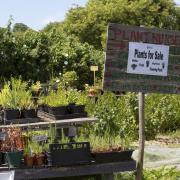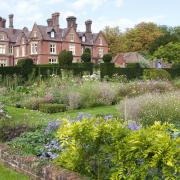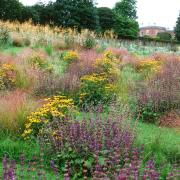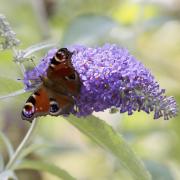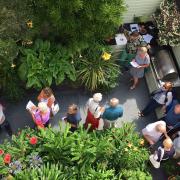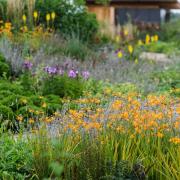Exuberant, romantic planting set behind high walls is the crowning glory at Goodnestone Park through the summer

One of Kent’s finest gardens, Goodnestone Park, is a favourite for return visitors with its 10-acre gardens of informal and formal areas.
From mature trees and woodland, through vistas over extensive lawns to the quintessentially English walled garden, there is much to explore. The gardens that have been compared to Sissinghurst, but without the crowds, have evolved over time and include the 17th-century walled garden, 18th-century parkland, 20th-century woodland, a Millennium parterre and a contemporary gravel and grasses garden.
The impressive, privately owned house was built in 1704 by Brook Bridges and in the early 18th century it was surrounded by formal gardens. These were then replaced by Sir Brook Bridges, the third baronet later in the 18th century with a landscaped park, as was the fashion at the time.
Also of significance was that the third baronet married Fanny Fowler, who was a co-heiress of the ancient Norman barony of FitzWalter; their daughter Elizabeth married Jane Austen’s brother Edward.

Today you can walk in Jane’s steps by following the reinstated 18th-century Serpentine Walk, easily imagining her strolling the lawns and admiring the views when she made regular visits to her cousins.
Further important alterations to the gardens came during the 1840s when the fifth baronet changed the entrance to the house and created a new approach drive with terraced lawns accessed with central steps.
The last of the Bridge’s family, a sister of the last baronet, married into the Plumptre family and their son Henry was able to claim the ancient FitzWalter barony in 1924.
He was then succeeded by his nephew Brook Plumptre, the 21st Lord FitzWalter, in 1952, who married Margaret Deedes, a passionate gardener. She certainly put her stamp on the garden, restoring and adding to it from the 1960s, to create what many regards as one of England’s outstanding country gardens.

Since the death of Lord FitzWalter, Julian Plumptre, the eldest of five sons has succeeded to the title.
A love of gardening runs deep in the family and the evolution continues within this historic framework, guided by the youngest of the five sons Francis Plumptre, head gardener Paul Bagshaw, three part-time assistants and some volunteers.
Working with the existing gardens and conditions, along with the alkaline loam soil over chalk and an outcrop of acid greensand, allows for a wide palette of plants – from roses to ericaceous choices.
The encompassing atmosphere is one of timeless tranquillity that the late Margaret, The Lady FitzWalter, so loved. Her dedication to the beauty of the garden is still felt as you walk the long borders in the walled garden or gaze over the formal pond to the church tower beyond, enjoying the calming vistas she instigated.

“Lady FitzWalter was instrumental in defining the garden’s personality, the pastel palette shows a feminine touch,” says Paul.
There are three main areas within the walled garden, each enticing you to explore further as they offer glimpses to the church through a succession of mellow brick-walled enclosures softened by climbers.
The first area is probably everyone’s favourite, especially in May and June, with long herbaceous borders at their peak of bloom, effervescent with hundreds of fragrant old-fashioned roses accompanied by billowing perennials.
Quintessentially English, there are roses in every shade, from creamy whites and soft apricots to blush pink and crimson, mixed with spires of foxgloves and lupins, blocks of hardy geraniums, and clematis on obelisks, all in a controlled, yet wild abundance.

Borders are more streamlined and colour-themed in the next two sections, around the periphery of the long rill reflective pond and a mirrored ebullient set in the third compartment beside the productive kitchen garden with its joyous mix of cutting flowers, vegetable and fruit.
New developments include refreshing and adding to areas to keep the horticultural interest going from spring to late summer for visitors. “The focus for the most interest is when the garden is at its busiest, with a main flourish in May and June in the walled garden,” explains Paul.
“We don’t want to disturb the essence of the garden but need to remove some of the roses that are not as vigorous now as they were and will be planting, in stages, some scented David Austin repeat-flowering roses with pale pinks and pastels but also some stronger colours in purple and yellow. All pastels would be a too wishy-washy; some heavy colours give more depth.”
As well as enjoying the colour and scent in the walled garden, allow time to wander the paths of the woodland with shrub plantings of cornus, hydrangeas and eucryphias, admire the emerging lavender in the large formal parterre by the house and discover the arboretum and the modern gravel garden.

You can also buy plants propagated from the garden at the nursery, to grow a bit of Goodnestone in your own garden.
Find out more
Goodnestone Park Gardens, Wingham CT3 1PL

Apr-Sept Sun, Tue, Wed, Thu, Bank Holiday Mondays (11am-5pm)
Admission £7, child £2
Tearoom open May to August on garden open days
Volunteers welcome, contact the office on 01304 840107

www.goodnestoneparkgardens.co.uk
Get the look
• Structure from hedging and formal lawns softened with effervescent herbaceous borders

• Herbaceous borders evolved from humble cottage gardens with their jumble of ornamentals and edibles
• The position of your borders will influence your plant choices
• A shady spot is suited to a woodland spring border, a south-facing sunny aspect for a summer border and an autumnal border looks lovely against setting sun in a south-west location
• Are you after a long season of interest or a crescendo of colour at a specific time?

• Plant choices go from spring bulbs and perennials to autumn grasses, bulbs and late season perennials
• Classic summer plants for herbaceous borders – achillea, allium, alstroemeria, delphinium, dianthus, eryngium, geranium, lupin, penstemon, phlox, poppies and lots of old-fashioned scented roses
• Consider your colour scheme - soft, harmonious to bright and clashing, the choice is yours
• Don’t plant an assortment of just one specimen of each plant as that will look bitty, it’s better to restrict your plant palette to maybe ten plants that you really love and suit your conditions, then plant three, five, seven or nine of each in a more natural, rhythmical tapestry
Plant of the month
Syringa, lilac
• beautiful scented flowers
• mauve, white, cream, pink and even lemon flowers
• different-sized shrubs available
Growing notes
• hardy
• full sun
• prefer neutral to alkaline, enriched well-drained soil
• prune out any crossing branches in late winter or early spring
Jobs to be done in May
• Finish sowing hardy annuals and at end of month plant out summer bedding, such as begonias, petunias, pelargoniums and antirrhinum
• Good time to plant out young dahlias and cannas
• Many perennials may benefit from the Chelsea chop by being cut back by half, for example rudbeckia, sedum and helenium, to make sturdier plants that will flower slightly later
• Deadhead tulips and spring bulbs but allow foliage to die down naturally
• Put stakes in place now for border plants before they get too tall
• Even the tiniest space can include productive plants, either in dedicated raised beds, containers or amongst your flowerbeds. Grow what you love to eat
• Crops to plant out this month include French beans, cucumbers, endive, lettuce, pumpkins, summer cabbages and courgettes




